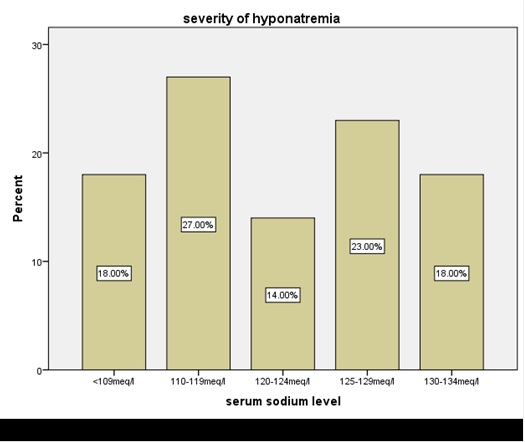A prospective study on the clinical profile and outcome of patients with hyponatremia in a tertiary care centre in Kerala, South India
Abstract
Background: Hyponatremia is the commonest electrolyte disturbance seen in hospitalized patients. The presence of hyponatremia worsens the prognosis in ill patients.
Aims: To study the clinical profile and outcome of patients having hypoosmolal hyponatremia. Methods: We studied a total of 100 consecutive patients, with serum sodium concentration less than135meq/l. The study was conducted in a tertiary care centre in Kerala, South India. Those patients with hyponatremia who had normal or high serum osmolality were excluded from the study. Serum sodium was estimated using ion sensitive electrodes.
Results: There were 55 (55%) male patients and 45 (44%) female patients. The ages ranged from 18 years to 88 years, with a mean age of 60+/-16 years. The most common precipitating factor was neurological and lung conditions. Majority of the patients were asymptomatic at the time of detecting hyponatremia. Majority of the patients were euvolemic at the time of detection of hyponatremia. Among the patients with euvolemic hyponatremia we estimated the ratio of urinary to serum electrolytes.
Conclusion: The conclusion we have drawn from this study is that euvolemic hyponatremia with urine sodium wasting is a more common cause for hyponatremia than conditions leading to hypovolemia. Since majority of the cases are asymptomatic, estimation of the serum electrolytes should be done as a routine in all hospitalized patients. Early recognition of hyponatremia and appropriate intervention would go a long way in improving the outcome. In the management the importance of determining the free water excretion has to be emphasized.
Downloads
References
2. Renneboog B, Musch W, Vandemergel X, Manto MU, Decaux G (2006) Mild chronic hyponatremia is associated with falls, unsteadiness and attention deficits. Am J Med 2005; 119: 71.e1–8. doi: 10.1016/j.amjmed.2005.09.026
3. Corona G, Giuliani C, Parenti G, et al. Moderate hyponatremia is associated with increased risk of mortality: evidence from a meta-analysis. PLoS One 2013; 8(12):e80451 doi: 10.1371/journal.pone.0080451. eCollection 2013.
4. Upadhyay A, Jaber BL, Madias NE. Incidence and prevalence of hyponatremia. Am J Med.2006;119(Suppl 1):S30–5DOI: http://dx.doi.org/10.1016/j.amjmed.2006.05.005
5. Manisha Sahay , Rakesh Sahay Hyponatremia: A practical approach Indian J Endocrinol Metab. 2014; 18(6): 760–771. DOI: 10.4103/2230-8210.141320
6. Taipei Liang-Kung Chen, Ming-Hsien Lin, Shinn-Jang Hwang, Tzen-Wen Chen Hyponatremia Among the Institutionalized Elderly in 2 Long-Term Care Facilities in J Chin Med Assoc. 2006;69(3):115-119 doi:10.1016/S1726-4901(09)70188-1
7. Jameela Al-Salman, David Kemp, Daniel Randall Hyponatremia West J Med. 2002 May; 176(3): 173–176.
8. Janicic N, Verbalis JG. Evaluation and management of hypo-osmolality in hospitalized patients. Endocrinol Metab Clin North Am 2003; 32:459–481 DOI: http://dx.doi.org/10.1016/S0889-8529(03)00004-5
9. Paniker G.I. , Joseph S A prospective study on clinical profile of hyponatremia in ICU hospitalized patients International Journal of Biomedical And Advance Research.2014;5(6)297-303
10. Nandini Chatterjee, Nilanjan Sengupta, Chanchal Das, Atanu Roy Chowdhuri, Ashis Kumar Basu, and Salil Kumar PalA descriptive study of hyponatremia in a tertiary care hospital of Eastern India. Indian J Endocrinol Metab. 2012; 16(2): 288–291. doi: 10.4103/2230-8210.93757
11. Rao MY, Sudhir U, Anil Kumar T, Saravanan S, Mahesh E, Punith K. Hospital-based descriptive study of symptomatic hyponatremia in elderly patients. J Assoc Physicians India. 2010;58:667-9
12. Maurice Laville, Volker Burst, Alessandro Peri, Joseph G. Verbalis Hyponatremia secondary to the syndrome of inappropriate secretion of antidiuretic hormone (SIADH): therapeutic decision-making in real-life cases Clin Kidney J. 2013; 6(1): i1–i20. doi: 10.1093/ckj/sft113

Copyright (c) 2016 Author (s). Published by Siddharth Health Research and Social Welfare Society

This work is licensed under a Creative Commons Attribution 4.0 International License.


 OAI - Open Archives Initiative
OAI - Open Archives Initiative


